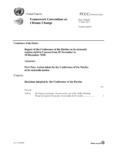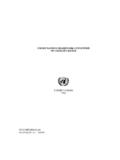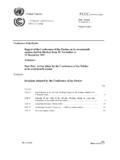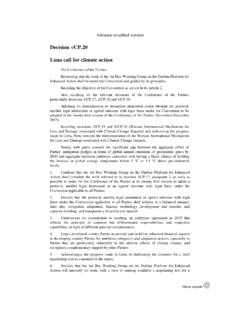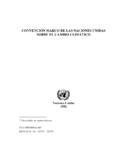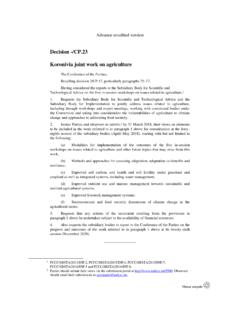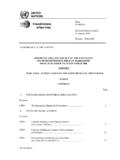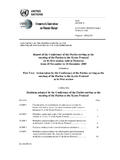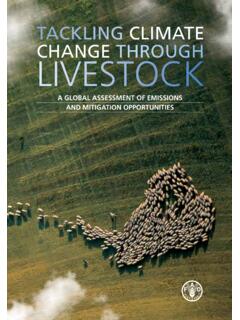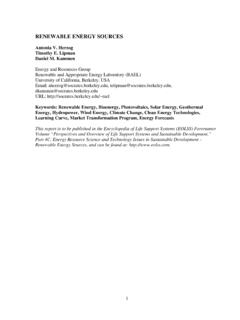Transcription of UNITED NATIONS FRAMEWORK CONVENTION ON CLIMATE …
1 HANDBOOKUNITED NATIONSFRAMEWORKCONVENTIONON CLIMATE CHANGE 2006 UNFCCC, all rights reserved UNITED NATIONS FRAMEWORK CONVENTION on CLIMATE Change:Handbook. Bonn, Germany: CLIMATE Change Secretariat Produced by Intergovernmental and Legal Affairs, CLIMATE Change SecretariatContributing editors: Daniel Blobel and Nils Meyer-Ohlendorf of Ecologic Institute forInternational and European Environmental Policy, Berlin, and Carmen Schlosser-Allera andPenny and layout: in Halesworth, UK by Technographic Design and Print Ltd using chlorine free paperfrom sustainable forests accredited with EMAS environmental certificationDisclaimer and RightsThis publication is issued for public information purposes and is not an official text of theConvention in any legal or technical sense.
2 Unless otherwise noted in captions or graphics allmatter may be freely reproduced in part or in full, provided the source is further information, contact: CLIMATE Change Secretariat (UNFCCC)Martin-Luther-King-Strasse 853175 Bonn, GermanyTelephone: + 49 228 815 1000 Telefax: + 49 228 815 1999 Email: Web: ISBN: 92-9219-031-8 UNITED NATIONS FrameworkConvention on CLIMATE ChangeHandbookList of boxes4 List of tables6 Acronyms, abbreviations and general expressions7 List of Parties and Observer States and their ISO 11three-letter country codesForeword14 Scope and purpose of the handbook15 Introduction: CLIMATE change16 History and development of the CONVENTION 17 Chapter 1:Objective and principles of the Objective Principles 23 Chapter 2:Institutional arrangements who does The Conference of the Parties (COP) COP President and Subsidiary Bodies (SBs) The secretariat Other rules of Financial rules: budget and financing 41 Chapter 3:Parties, groups and observer states who is Parties to the Groups of Parties under the Regional Political negotiating Observer States51 Chapter 4.
3 Cooperation with UN bodies/agencies and52intergovernmental Institutional linkage of the CONVENTION secretariat to 52the UNITED Intergovernmental Panel on CLIMATE Change (IPCC) Cooperation with other environmental agreements56 Chapter 5:Observer organizations and the General rules: participation and rights of observers UNITED NATIONS bodies and agencies Other IGOs and NGOs The media 64 Chapter 6:Multilateral consultative process: Article 1365 Chapter 7:Settling disputes 67 Chapter 8:Amending the Convention69 Chapter 9:Adopting, amending and reviewing annexes702 UNFCCC HandbookContentsChapter 10: Adopting protocols71 Chapter 11: Mitigating CLIMATE Measures to mitigate CLIMATE change: all Parties Measures to mitigate CLIMATE change: Annex I Measures to mitigate CLIMATE change: 88non-Annex I Other areas of relevance for mitigation 91 Chapter 12: Adapting to CLIMATE Relevant provisions of the CONVENTION Work related to adaptation under the CONVENTION 93 Chapter 13: Providing financial General provisions and arrangements COP guidance to the GEF Sources of funding 127 Chapter 14: Developing and transferring FRAMEWORK for technology transfer Expert Group on Technology Transfer (EGTT) Activities of Parties Activities of the secretariat TT:CLEAR145 Chapter 15.
4 Furthering research and systematic Research Systematic observation 150 Chapter 16: Promoting education, training and public awareness Provisions of the CONVENTION The New Delhi work programme 157 Chapter 17: Building Capacity-building in the CONVENTION process Frameworks for capacity-building under 163the Funding for capacity-building 168 Chapter 18: Communicating information on General provisions for the communication 171of information by National communications from Annex I Parties greenhouse gas inventories from Annex I Parties National communications from non-Annex I Parties 193 Chapter 19: Keeping up the momentum: the dialogue205 Index206 Decisions of the COP206 Key terms214 Contents34 UNFCCC HandbookList of boxesBox :GHGs under the Kyoto Protocol23 Box :Principle 7 of the 1992 Rio Declaration on 23 Environment and DevelopmentBox :Principle 6 of the 1992 Rio Declaration on 24 Environment and DevelopmentBox :Principle 15 of the 1992 Rio Declaration on 24 Environment and DevelopmentBox.
5 Principle 3 of the 1992 Rio Declaration on 25 Environment and DevelopmentBox :Principle 12 of the 1992 Rio Declaration on 26 Environment and DevelopmentBox :The Conference of the Parties serving as the meeting 28of the Parties to the Kyoto Protocol (COP/MOP)Box :Ad hoc working group on Further Commitments for 38 Annex I Parties under the Kyoto Protocol (AWG)Box :Constituted bodies under the Kyoto Protocol40 Box :Annex I to the CONVENTION 46 Box :Annex II to the CONVENTION 47 Box :Countries with economies in Transition 48 Box :Decisions of the Parties and corresponding UNITED NATIONS 53 General Assembly resolutions on institutional :Side-events and exhibits61 Box :Admission of observer organizations to the COP/MOP63 Box : Decision 1/CP3 adopting the Kyoto Protocol72 Box : Major objectives of CLIMATE change policies of Annex I 79countriesBox : LULUCF under the Kyoto Protocol 84 Box : Core elements of the Kyoto Protocol 86 Box : Scientific and methodological assessment of 88contributions to CLIMATE change: the Brazilian proposalBox : Measures to combat CLIMATE change in non-Annex I 90countriesBox : Adapting to the adverse effects of CLIMATE change94 List of boxes5 Box : Guidelines for the preparation of NAPAs100 Box : Relevant Kyoto Protocol articles related to the impact 102of the implementation of response measuresBox.
6 Incremental , full and agreed costs in 115accordance to the GEFBox : The GEF Resource Allocation Framework119 Box : GEF operational programmes in the CLIMATE change 129focal areaBox : Adaptation Fund136 Box : Research and systematic observation under the 148 Kyoto ProtocolBox : International bodies and programmes active in research 149activities relevant to the ConventionBox : The Global CLIMATE Observing System (GCOS)150 Box : Group on Earth Observations153 Box : Education, training and public awareness in the 157 Kyoto Protocol Box : Aspects of capacity-building162 Box : Capacity-building under the Kyoto Protocol164 Box : Support for capacity-building from Annex I Parties 165 Box : Provisions for national communications under the 172 Kyoto ProtocolBox : Additional information relevant to Annex I Parties fourth 175national communicationBox : Content of national communications Annex I Parties 176 Box : Review under the Kyoto Protocol179 Box : Guidance for national systems and application of 182adjustments under Article 5 of the Kyoto ProtocolBox : Emissions from bunker fuels used for international 186aviation and navigationBox : Explanations of specific terms related to inventories188 Box : LULUCF reporting189 Box.
7 Content of national communications non-Annex I Parties196 Table : Overview of COP sessions held to date30 Table : Sessions and Chairs of the SBSTA32 Table : Sessions and Chair of the SBI34 Table : UNFCCC budget 2006 200742 Table : Pledged resource levels of the GEF Trust Fund127 Table : GEF Trust Fund allocations on CLIMATE Change128 Table Bilateral financial contributions related to adaptation166in the implementation of the UNFCCC, 1997 2000 (millions of US$)6 UNFCCC HandbookList of tables7 Acronyms, abbreviations and general expressionsAAUA ssigned amount unit (exchanged through emissions trading)AFAdaptation FundAFOLUA griculture, Forestry and other Land-UseAG13 Ad Hoc Group on Article 13 (1995 1998)AGBMAd Hoc Group on the Berlin Mandate (1995 1997)AIJA ctivities Implemented Jointly (under the pilot phase)AIPA nnex I PartiesAOSISA lliance of Small Island StatesAR4 Fourth Assessment Report (by the IPCC)
8 Hoc Working Group on Further Commitments for Annex I Parties under the Kyoto Protocol BAPAB uenos Aires Plan of Action (decided at COP 4 in 1998)BINGOB usiness and industry non-governmental organizations (observerconstituency)C2F6 TetrafluoroethaneCACAMC entral Asia, Caucasus, Albania and Moldova (as a negotiating group)CBDC onvention on Biological DiversityCDIC apacity Development Initiative (of GEF/UNDP)CDMC lean Development Mechanism (under the Kyoto Protocol)CDM EBCDM Executive BoardCEOC hief Executive OfficerCERC ertified emission reduction (generated through the CDM)CF4 Carbon TetrafluorideCFCC hlorofluorocarbonCG-11 Central Group 11 (former negotiating group, replaced by the Central Group)CGEC onsultative Group of Experts on National Communications from Non-Annex I PartiesCH4 MethaneCOCarbon monoxideCO2 Carbon dioxideCOPC onference of the Parties (to the UNFCCC)COP/MOPC onference of the Parties serving as the meeting of the Parties to theKyoto ProtocolCOWC ommittee of the WholeCPFC ollaborative Partnership on ForestsCRFC ommon reporting formatDACD evelopment Assistance Committee (of the OECD)EAEnabling Activity (GEF project category)ECEuropean CommunityEGTTE xpert Group on Technology TransferEIGE nvironmental Integrity Group (negotiating group)
9 EITE conomy in transition (countries of the former Soviet Union and Central and Eastern Europe which are undergoing the process of transition to a market economy)ENGOE nvironmental non-governmental organizations (observer constituency)ERUE mission reduction unitEUEuropean UnionFAOFood and Agriculture Organization of the UNITED NationsFARF irst Assessment Report (by the IPCC)FCCCF ramework CONVENTION on CLIMATE Change (= UNFCCC)FSPFull-Size Project (GEF project category)G-77 Group of 77 and China (a coalition of developing countries in the UN context)GCOSG lobal CLIMATE Observing SystemGEFG lobal Environment FacilityGEOAd hoc Group on Earth ObservationsGEOSSG lobal Earth Observation System of SystemsGETG lobal Environment Trust Fund (replaced by the GEF Trust Fund)GHGG reenhouse gasGOOSG lobal Ocean Observing SystemGRULACG roup of Latin America and Caribbean States (UN regional group)
10 GTOSG lobal Terrestrial Observing SystemGTZG erman Technical Cooperation AgencyGWPG lobal warming potentialHCFCH ydrochlorofluorocarbonHFCH ydrofluorocarbonHWPH arvested wood productsIAEAI nternational Atomic Energy AgencyICAOI nternational Civil Aviation OrganizationICJI nternational Court of JusticeICSUI nternational Council of Scientific UnionsIEAI nternational Energy
